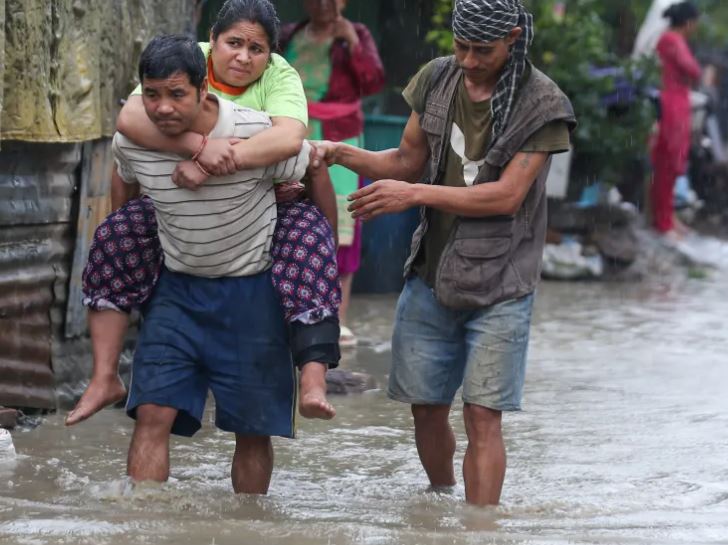Catastrophic Floods and Landslides in Nepal
Severe monsoon rains in Nepal have unleashed devastating floods and landslides, resulting in the deaths of at least 14 individuals and leaving nine others missing. The relentless downpours have triggered widespread destruction across the country, with search and rescue teams working tirelessly to locate those unaccounted for. The Nepalese police, in collaboration with other agencies and local communities, are at the forefront of these efforts.
Widespread Damage Across South Asia
The impact of the monsoon extends beyond Nepal, with flooding causing significant havoc in India and downstream in Bangladesh. The torrential rains have led to widespread devastation, affecting millions of lives across these regions. In India’s northeastern state of Assam, the relentless floods have claimed six lives in the past 24 hours alone, bringing the total death toll since mid-May to 58. Meanwhile, in Bangladesh, more than two million people have been impacted by the floods, exacerbating the already dire situation.
The Role of Climate Change and Human Activities
Experts attribute the increasing frequency and severity of floods and landslides in South Asia to climate change and human activities such as road construction. The monsoon rains, which typically span from June to September, have become more unpredictable and intense, resulting in catastrophic outcomes. The heavy rainfall in Nepal since July 4 has prompted disaster authorities to issue warnings of flash floods in multiple rivers, highlighting the urgent need for effective disaster management strategies.
Flash Floods and Inundation in Nepal
Numerous districts in Nepal, especially those bordering India, have reported severe inundation. The lowland areas have borne the brunt of the monsoon’s fury, with rivers swelling and overflowing their banks. The aftermath of these floods is a stark reminder of the vulnerabilities faced by the region during the monsoon season. Last month, Nepal witnessed a similar catastrophe when 14 people were killed in storms that brought landslides, lightning, and flooding.
Devastation in Assam, India
In Assam, the situation remains grim as floodwaters continue to submerge vast areas, displacing thousands and causing extensive damage to property and infrastructure. The Assam Disaster Management Authority has been actively involved in rescue and relief operations, but the scale of the disaster has overwhelmed the resources at hand. The incessant rains have not only claimed lives but also disrupted the livelihoods of many, leaving a trail of destruction in their wake.
Bangladesh: A Nation in Peril
Bangladesh, positioned downstream from India, faces a perpetual battle against floods due to its geographical location. The confluence of the Ganges and Brahmaputra rivers in the low-lying delta regions makes the country particularly susceptible to flooding. The current deluge has severely impacted more than two million people, with homes, farmlands, and infrastructure submerged under water. The government’s disaster management agency is working round-the-clock to provide relief, but the enormity of the crisis poses significant challenges.
The Need for Sustainable Solutions
The recurrent nature of these disasters calls for sustainable and long-term solutions. Addressing the root causes, such as climate change and unplanned development, is crucial in mitigating the impacts of such catastrophic events. Strengthening infrastructure, improving early warning systems, and fostering community resilience are imperative steps that need to be taken to safeguard the vulnerable populations of South Asia.
Conclusion: A Call for Global Attention
The devastating floods and landslides in Nepal and across South Asia serve as a poignant reminder of the region’s vulnerability to natural disasters. The human and economic toll of these events is immense, necessitating a concerted effort from governments, international organizations, and communities to build resilience and ensure sustainable development. The time to act is now, to prevent further loss of life and to protect the livelihoods of millions of people who face the brunt of nature’s wrath each monsoon season.
Summary:
| Key Learning Points |
|---|
| Nepal faces catastrophic floods and landslides, with 14 dead and nine missing. |
| Floods in India and Bangladesh cause widespread devastation, affecting millions. |
| Climate change and human activities exacerbate the severity of floods. |
| Assam, India, and low-lying Bangladesh are severely impacted by the monsoon. |
| Sustainable solutions are crucial to mitigate future disasters. |
Soumya Smruti Sahoo is a seasoned journalist with extensive experience in both international and Indian news writing. With a sharp analytical mind and a dedication to uncovering the truth, Soumya has built a reputation for delivering in-depth, well-researched articles that provide readers with a clear understanding of complex global and domestic issues. Her work reflects a deep commitment to journalistic integrity, making her a trusted source for accurate and insightful news coverage.



